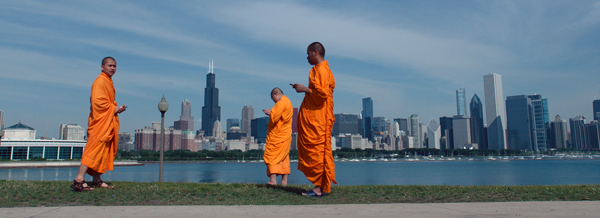No other filmmaker has gone to every continent on the planet like Werner Herzog has done in his nearly 50 years of making films; the man’s seen child soldiers, erupting volcanoes, suicidal penguins, a delusional friend to bears, and even the Dalai Lama. (Look at his IMDb page. I’m only scratching the surface.) But in 2016, Herzog finally decided to gaze on something that takes him all around the world while simultaneously keeping him in one place: the Internet.
It sounds like such a broad topic, like something that can’t be squeezed into a 98-minute documentary, and perhaps it’s a subject still waiting for a Ken Burns to come along to document in more specific detail. Not only does Herzog give us a fresh look at what the world wide web has done and can do, or has the capability of doing, but he looks ahead to the future and offers one of his classic Herzog-isms (if one can it such): “Does the Internet dream of itself?”
Lo and Behold is split up into 10 chapters, and the first two look at the early ages of the Internet, how it got started (hint, it wasn’t Al Gore), and how in 1968(!) Leonard Kleinrock and his team sent the very first word across Internet lines, “Lo,” because the word “Log” was missing the “g” on the end. Herzog also sees how the web is connected to the rise of artificial intelligence—once you have computers and networks that can move faster than almost the speed of light, technology and artificial intelligence is soon to follow—and offers the audience the amusing sight of robots playing a form of soccer (not with legs exactly; they are more like little droids out of Star Wars). And, perhaps, this is the future as well.
But what makes this documentary so engrossing is how Herzog so easily slips between the light and the dark, the good and the horrible. Chapter three is somewhat brief compared to the other segments and centers on victims of cyber harassment: a member of one family was decapitated in an accident and pictures of the severed head surfaced online. The way this short episode is staged feels like out of a Tim Burton movie, with the pale family in dark clothes sitting at a dinner table. (Herzog is known for some intentionally awkward staging of his subjects in his documentaries, but it feels like the family sits this way normally.) What the internet has done to them is horrible. Yet, is it the Internet or the people who use it that’s the issue?
This kind of question may be left up in the air for us to decide, but on a deeper level Herzog uses the subject to explore how obsessive the Internet makes people. Chapter four highlights two ways that it and interconnectivity has pushed users into a) a secluded environment where people hide away (he highlights a very small community in West Virginia that has banned the use of Wi-Fi, so townspeople actually have to talk to one another more), or b) abusing it like drugs or gambling and become addicted. And then there’s chapter five, which is perhaps the grimmest section, about how solar flares will, you know, probably wipe out humanity one day. (“It’s not a question of if but when,” an interviewee admits.)
Herzog’s now at a place where he is open to the sublime, Elon Musk—creator of PayPal and Tesla Motors—and his program to get people to travel to Mars, as well as the ridiculous, and he has a great sense of dark humor. He cuts at one point to the Chicago skyline early in the morning, pondering in his narration about this “abandoned” city while Elvis’s “Are You Lonesome Tonight?” pipes up, and then he pans to a group of Tibetan monks nearby who are lost in thought—looking at their smartphones.
If his film lacks anything overall it’s a few of those visually heart-stopping moments where his footage transports us into another realm. The closest we get here, aside from the Chicago scene, is when he features a robot unscrewing a jar and pouring the contents into a glass. It’s a simple action but, c’mon, it’s still a robot after all. How do those things work?

















Based on this review by the always astute Jack Gattanella this is on my must see list of films. Thank you!